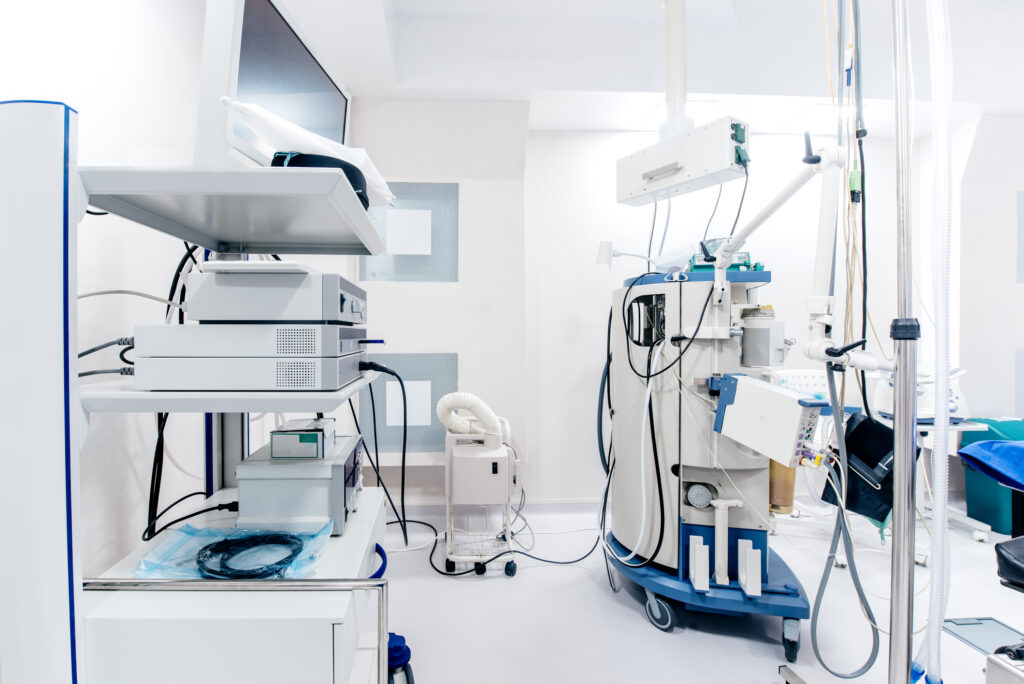Point-of-care imaging brings rapid, bedside diagnostics that enhance patient care and expedite clinical decisions.
Point of Care Diagnostic Imaging
The history of Point of Care (PoC) in medical imaging can be traced back to the desire to provide immediate diagnostic insights at the patient’s location, thereby speeding up medical decision-making and treatment. While the concept of PoC is broad and not limited to imaging, the evolution of PoC imaging technologies has been pivotal in transforming healthcare delivery.
The development of PoC began in earnest with the advent of technologies that allowed for miniaturisation and portability. In the 1980s, the first portable ultrasound machines were introduced. These early machines were still relatively bulky and had limited capabilities, but they represented a significant step forward in bringing imaging to the patient’s bedside.
Throughout the 1990s, advances in battery technology, digital imaging, and computing power enabled further miniaturisation and improved the quality of PoC imaging devices. By the 2000s, handheld ultrasound devices had become increasingly sophisticated, with some even being able to connect to smartphones, thereby democratising ultrasound use across various medical specialties.
The 21st century has seen a rapid expansion in the variety and capability of PoC imaging devices. Digital stethoscopes, portable X-ray machines, and even mobile CT scanners have become more commonplace in medical settings, ranging from emergency rooms to remote clinics. The integration of wireless technology has facilitated the real-time sharing of images and data, enhancing collaborative care and telemedicine.
The COVID-19 pandemic underscored the value of PoC imaging, particularly portable ultrasound and X-ray devices, which played a crucial role in managing and monitoring respiratory conditions while reducing the risk of virus transmission within hospitals.
| PoC Imaging Device | Applications |
| Handheld Ultrasound | Cardiac function assessment, abdominal examinations, pregnancy monitoring, vascular access, musculoskeletal injuries |
| Portable X-Ray | Chest radiography, bone fractures, and bedside imaging for immobile patients |
| Mobile CT Scanner | Brain imaging for strokes, head injuries, lung imaging, intraoperative assessments |
| Portable MRI | Brain scans, spinal cord imaging, musculoskeletal system, emergency room assessments |
| Digital Stethoscope | Cardiac and pulmonary assessments, heart and lung sounds analysis, telemedicine consultations |
| Dermatoscope | Skin lesion analysis, melanoma detection, teledermatology |
| Ophthalmoscope | Retinal exams, glaucoma screening, assessment of diabetic retinopathy |
| Otoscope | Ear examinations, tympanic membrane visualisation, diagnosis of ear infections |
| Capnography | Monitoring ventilation status, end-tidal CO2 levels in intubated patients, procedural sedation |
| Spirometer | Lung function tests, asthma management, COPD monitoring |
Redefining Healthcare Delivery: The Impact and Future of Point of Care Imaging
The Point of Care (PoC) in medical imaging represents a paradigm shift in healthcare delivery, where diagnostic processes are brought directly to the patient’s bedside or to the location where care is provided. This approach significantly enhances the efficiency of healthcare delivery, patient comfort, and the immediacy of treatment decisions. It includes a wide array of technologies like portable X-rays, handheld ultrasound devices, and mobile CT scanners.
The core advantage of PoC imaging is the drastic reduction in the time from presentation to diagnosis. Traditional imaging workflows involve transporting the patient to the radiology department, which can be time-consuming and potentially harmful to critical patients. With PoC, the imaging device is brought to the patient, which is especially beneficial in emergency situations, intensive care units, and rural or underserved areas where access to full-scale radiology departments is limited.
Another significant benefit is the enhancement of patient-centred care. PoC allows for more significant patient-physician interaction during the diagnostic process, fostering a more inclusive environment for patient care. It empowers clinicians to make faster, more informed decisions, which can lead to quicker interventions and better outcomes.
Moreover, PoC imaging is integral in managing infectious diseases, as it minimises the need for patient transportation, reducing the risk of spreading infections within healthcare facilities. This was particularly highlighted during the COVID-19 pandemic, where portable imaging devices were crucial in diagnosing and monitoring lung infections while maintaining isolation protocols.
With the advancement in technology, PoC devices are becoming more sophisticated, offering image qualities and diagnostic capabilities that approach those of traditional imaging systems. Integration of PoC imaging with telemedicine platforms also allows for remote diagnostics and consultation, further expanding the reach of immediate, high-quality care.
Despite these benefits, PoC also presents challenges. Proper training and quality control are needed to ensure accurate diagnoses. If not carefully managed, the ease of use of PoC devices could lead to overutilisation and increased healthcare costs. Furthermore, there are logistical challenges in maintaining and sterilising portable devices, especially in high-turnover settings.
Emerging Trends Shaping the Future of Point of Care Imaging
The future of Point of Care (PoC) in medical imaging is poised to be shaped by several emerging trends and technological advancements. Here are some of the key areas that are likely to influence the trajectory of PoC:
- Artificial Intelligence and Machine Learning: AI will play a significant role in the future of PoC. Machine learning algorithms are becoming increasingly adept at analysing images for diagnostic purposes, potentially increasing the accuracy and speed of diagnoses made at the bedside.
- Wearable Technology: The development of wearable devices capable of continuous monitoring and imaging will further integrate PoC into daily healthcare management, providing real-time data to healthcare providers and patients.
- Telemedicine and Remote Diagnostics: With the rise of telehealth, PoC imaging devices will become more interconnected, allowing for remote diagnosis and specialist consultations, which will be particularly transformative for patients in rural or underserved regions.
- Miniaturisation and Enhanced Portability: Technological advancements will continue to make PoC devices smaller, more powerful, and easier to use, making it feasible for them to be used in a broader range of environments, from ambulances to battlefields.
- 3D Printing: This technology could enable the on-site production of custom components for PoC devices, facilitating repairs and adaptations that meet specific patient or clinical needs.
- Integrated Healthcare Systems: PoC devices will be increasingly integrated with electronic health records (EHRs), allowing for seamless updating of patient records with imaging results, which can improve care coordination and outcomes.
- Improved Imaging Quality: Ongoing improvements in sensor technology will likely enhance the image quality of portable devices, making them comparable to their stationary counterparts.
- Cost Reduction: Economies of scale and improved manufacturing techniques are expected to lower the costs of PoC devices, making them more accessible to healthcare providers worldwide.
- Regulatory Support: As the efficacy and importance of PoC imaging are increasingly recognised, regulatory bodies may provide more robust guidelines and support for their use, which could lead to broader adoption.
- Education and Training: As PoC devices become more common, medical education will adapt to provide healthcare professionals with the necessary skills to utilise these tools effectively.
Conclusion
Point of Care in medical imaging is a transformative approach that brings diagnostics closer to the patient, streamlines the care process, and potentially improves clinical outcomes. Its continued integration into healthcare systems will depend on balancing its benefits with cost management and maintaining high standards of care.
Today, PoC imaging is an integral part of modern medicine, with continuous innovation improving accessibility, quality, and affordability of care. As we look to the future, the history of PoC reflects a journey towards a more immediate, patient-centred approach to diagnosis and treatment, an evolution driven by technological advancements and the ever-present need for timely medical care.
Disclaimer
The content provided in this article is for informational and educational purposes only and does not constitute medical advice, diagnosis, or treatment. While every effort has been made to ensure the accuracy of the information at the time of publication, Open Medscience does not guarantee its completeness or reliability. The technologies, devices, and practices mentioned may not be suitable for all clinical settings or patient populations and should not replace professional judgement or institutional guidelines. Healthcare professionals should rely on their own expertise and consult appropriate sources before making clinical decisions. Open Medscience is not responsible for any actions taken based on the information in this publication. Always consult a qualified healthcare provider for personalised medical guidance.




